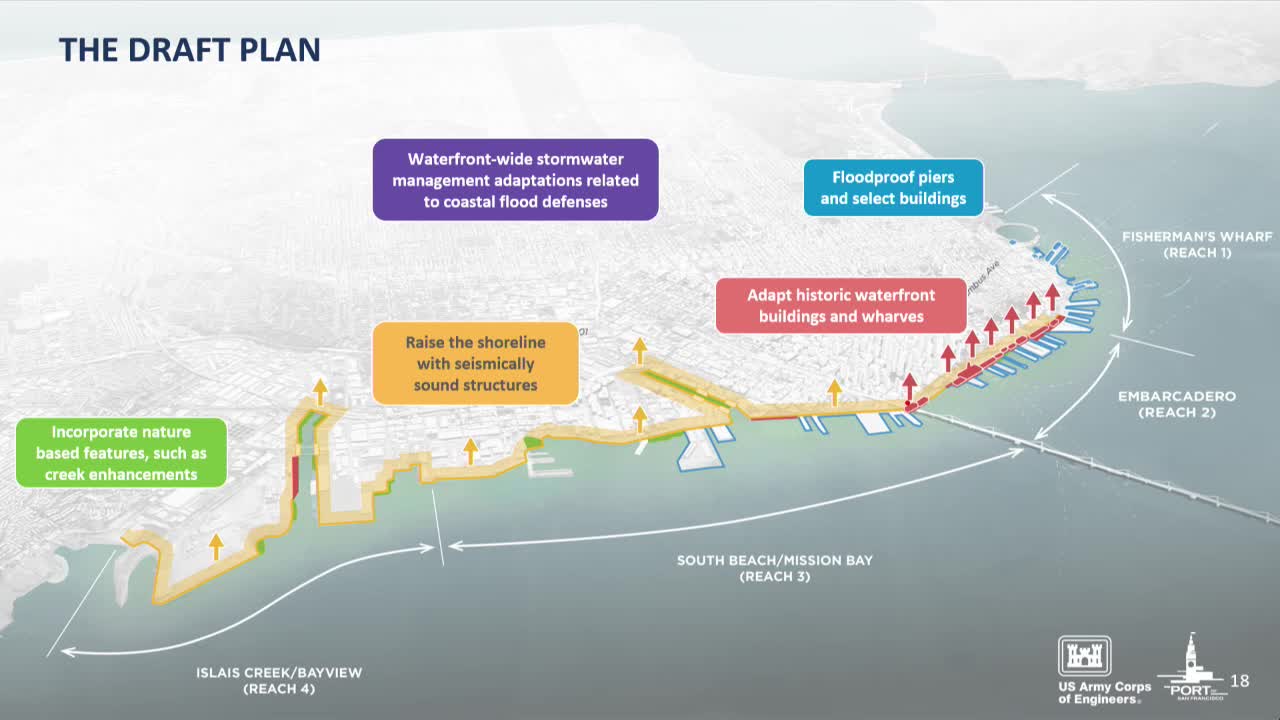San Francisco outlines flood defense plan from Herons Head Park to Aquatic Park
February 07, 2024 | San Francisco City, San Francisco County, California

This article was created by AI summarizing key points discussed. AI makes mistakes, so for full details and context, please refer to the video of the full meeting. Please report any errors so we can fix them. Report an error »

The recent government meeting in San Francisco focused on a comprehensive flood management plan aimed at addressing rising sea levels and enhancing public safety along the waterfront. The plan, which spans from Herons Head Park to Aquatic Park, is divided into four sub-areas, each with tailored strategies to mitigate flood risks and improve infrastructure resilience.
Key discussions highlighted the need for elevating shorelines and making seismic improvements to existing structures, particularly historic wharves and the iconic Ferry Building. The proposed measures include flood-proofing select buildings in Fisherman's Wharf and adding nature-based features to enhance habitat and drainage. The plan emphasizes community feedback gathered over the past six years, prioritizing life safety, public access, and social equity, especially in southeastern neighborhoods.
In the Fisherman's Wharf area, which is relatively elevated and less prone to flooding, the strategy involves flood-proofing key buildings and constructing low flood walls around piers. Conversely, the Embarcadero area, characterized by significant flood risk and economic vulnerability, will see more extensive measures. Here, the plan proposes to defend against up to 3.5 feet of sea level rise through a one-time construction effort to minimize disruption to the densely built environment.
The South Beach and Mission Bay areas will also see shoreline elevation, but with a focus on defending against 1.5 feet of sea level rise. This phased approach allows for gradual adaptation while maintaining access to the waterfront.
Overall, the meeting underscored the city's commitment to proactive flood management and infrastructure resilience, aiming to safeguard both the community and the environment in the face of climate change challenges. The next steps will involve further planning and community engagement as the city moves forward with these critical initiatives.
Key discussions highlighted the need for elevating shorelines and making seismic improvements to existing structures, particularly historic wharves and the iconic Ferry Building. The proposed measures include flood-proofing select buildings in Fisherman's Wharf and adding nature-based features to enhance habitat and drainage. The plan emphasizes community feedback gathered over the past six years, prioritizing life safety, public access, and social equity, especially in southeastern neighborhoods.
In the Fisherman's Wharf area, which is relatively elevated and less prone to flooding, the strategy involves flood-proofing key buildings and constructing low flood walls around piers. Conversely, the Embarcadero area, characterized by significant flood risk and economic vulnerability, will see more extensive measures. Here, the plan proposes to defend against up to 3.5 feet of sea level rise through a one-time construction effort to minimize disruption to the densely built environment.
The South Beach and Mission Bay areas will also see shoreline elevation, but with a focus on defending against 1.5 feet of sea level rise. This phased approach allows for gradual adaptation while maintaining access to the waterfront.
Overall, the meeting underscored the city's commitment to proactive flood management and infrastructure resilience, aiming to safeguard both the community and the environment in the face of climate change challenges. The next steps will involve further planning and community engagement as the city moves forward with these critical initiatives.
View full meeting
This article is based on a recent meeting—watch the full video and explore the complete transcript for deeper insights into the discussion.
View full meeting
